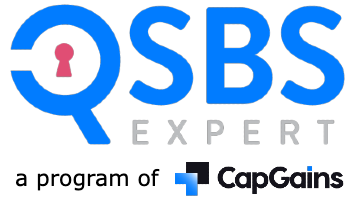Going public via a Special Purpose Acquisition Company (SPAC) acquisition is quickly becoming one of, if not the main way to IPO. The number of SPAC IPOs rose at a value of 320% from 2019 to 2020. Also, as of April 30, 2021, there were nearly double the number of SPACs from 2020 looking for their acquisition targets—according to KPMG’s April 2021 market report.
Security holders in an early stage company—that is being targeted by a SPAC—may be wondering what the acquisition means from a capital gains tax standpoint and if their gain may be eligible for a Qualified Small Business Stock tax exemption.
❝ If you hold stock or options to acquire stock in a Qualified Small Business that is likely to be acquired by a SPAC, you may want to consider what steps can be taken to maximize your tax benefits. ❞
What is a SPAC?
A SPAC is a publicly listed entity formed by a SPAC sponsor, who then raises capital by selling shares and has a 2 year period to acquire a target company. Whereas in a traditional IPO or a Direct Listing, a company’s existing shares begin trading on a stock exchange, in a SPAC listing, the SPAC entity acquires the target company by exchanging its shares for shares of the acquired company. This results in a Section 368 tax free transaction in most cases.
What is Qualified Small Business Stock?
Qualified Small Business Stock or QSBS provides for up to a 100% capital gains tax exemption if certain conditions, outlined in IRC Section 1202, are met. Eligibility criteria include needing to be a domestic C-Corporation in a qualified industry, having less than $50 million in gross assets when the stock is issued, and demonstrating that it is utilizing those assets for the qualified business purpose, amongst other requirements.
In order to qualify for the QSBS tax exemption, a shareholder needs to have met a 5-year holding period of their stock. The holding period start date can vary based on different securities and depending on when the securities become stock – i.e. stock options will not start counting towards the 5-year holding period until they are exercised.
A large portion of SPAC targets are VC-backed high growth US-based startups which likely qualify for QSBS; however, given the elements needed to qualify the company it is imperative that any company is examined closely to validate if it meets the QSBS eligibility criteria.
A SPAC entity itself is unlikely to be considered a Qualified Small Business given that “investment” companies are specifically excluded per IRC Section 1202(e)(3)(B).
What Happens when a SPAC acquires a Qualified Small Business Stock?
It is important to note that when a SPAC acquires a company that currently or at one time was a Qualified Small Business, it is likely that not all of the stock held in the target company would be considered QSBS. For example, some of the shares in the target company may have been acquired by holders in the secondary market, which would not be eligible for QSBS tax treatment given the “original issuance” QSBS requirement.
A SPAC acquisition of a target entity typically takes the form of a stock-for-stock reorganization pursuant to IRC Section 368. Since the SPAC shares themselves are not QSBS, the QSBS exclusion ceiling (as per IRC Section 1202(h)(4)(B)) will be set at the value of the consideration received on the effective date of the SPAC merger / acquisition (i.e. often determined by the closing price on the first day the merged company shares begin trading). Any further appreciation of the now public shares would likely not be eligible for the QSBS tax exemption. Alternatively, if a QSB goes through a traditional IPO, the QSBS shares would not be subject to the ceiling/cap.
If QSBS shares have not met the 5-year holding period at the time of the SPAC acquisition, the holding period will generally “tack” on to the new shares. If the holder holds the new shares for the remainder of the 5-years they can then benefit from the QSBS exemption, albeit only up to the exclusion ceiling/cap discussed previously.
What Should Investors Consider if they Hold QSBS in a Likely SPAC Target?
If you hold stock or options to acquire stock in a Qualified Small Business that is likely to be acquired by a SPAC, you may want to consider what steps can be taken to maximize your tax benefits. For example:
- Stock option holders may consider exercising stock options as soon as possible if the company is currently an eligible QSB entity.
- Shareholders should ensure they understand their basis in their stock to understand whether their gain may exceed the $10M or 10x basis Section 1202 exemption limits (whichever is greater.) If the Company was originally structured as an LLC and converted to a C Corporation there could have been a step up in basis (e.g. $0 basis to $4 million x 10 = $40 million exclusion)
- Shareholders with gains expected to exceed the exemption limits may want to consider whether certain planning strategies can be implemented to maximize the exemption through gifting/trusts.
Another common question regarding SPAC acquisitions and QSBS involves:
What if the stock price goes down before I sell?
Keep in mind that the “realized gain” only occurs when you actually sell your securities and receive cash. The “recognized gain” for QSBS purposes is not reported on your tax return at the time of the SPAC acquisition; however, as noted previously, the recognized gain will be the maximum amount eligible for the QSBS exemption. If your realized gain is ultimately below your “recognized gain” from the time of the SPAC acquisition, your entire gain may ultimately qualify for QSBS tax treatment.
Planning Ahead
If you are an early investor, employee or other shareholder in a potential Qualified Small Business being targeted by a SPAC, it is important to plan ahead to maximize your tax benefits. The first step with QSBS is ensuring that the company meets the QSBS eligibility criteria. Contact us to help assess if your company may be eligible.
This article does not constitute legal or tax advice. Please consult with your legal or tax advisor with respect to your particular circumstance.

